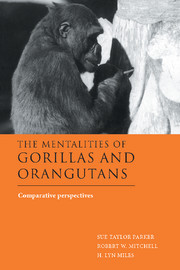Book contents
- Frontmatter
- Contents
- List of contributors
- Preface
- Acknowledgments
- I Comparative evolutionary and developmental perspectives on gorillas and orangutans
- II Cognition and tool use in gorillas and orangutans
- III Communication in gorillas and orangutans
- IV Social cognition in gorillas and orangutans
- 14 Comparative aspects of mirror self-recognition in great apes
- 15 Deception and concealment as strategic script violation in great apes and humans
- 16 Levels of imitation and cognitive mechanisms in orangutans
- 17 Parental encouragement in Gorilla in comparative perspective: implications for social cognition and the evolution of teaching
- 18 The development of social roles in the play of an infant gorilla and its relationship to sensorimotor intellectual development
- V Epilogue
- Index of authors
- Index of subjects
16 - Levels of imitation and cognitive mechanisms in orangutans
Published online by Cambridge University Press: 20 October 2009
- Frontmatter
- Contents
- List of contributors
- Preface
- Acknowledgments
- I Comparative evolutionary and developmental perspectives on gorillas and orangutans
- II Cognition and tool use in gorillas and orangutans
- III Communication in gorillas and orangutans
- IV Social cognition in gorillas and orangutans
- 14 Comparative aspects of mirror self-recognition in great apes
- 15 Deception and concealment as strategic script violation in great apes and humans
- 16 Levels of imitation and cognitive mechanisms in orangutans
- 17 Parental encouragement in Gorilla in comparative perspective: implications for social cognition and the evolution of teaching
- 18 The development of social roles in the play of an infant gorilla and its relationship to sensorimotor intellectual development
- V Epilogue
- Index of authors
- Index of subjects
Summary
INTRODUCTION
I have in mind not so-called instinctive and circular types of imitation nor, at the other extreme, indubitably rational and purposive imitation with full consciousness of the objective and of the relation of act to result. The latter we know in ourselves, but only a naive or uncritical student of behavior could assert that chimpanzees are capable of it. I refer instead to varieties of imitative behavior which lie between these extremes.
(R. M. Yerkes, 1943, p. 142)The scientific study of imitation in primates dates back to the beginning of the century. Several scholars investigated the question of imitation in monkeys and apes using various experimental approaches such as puzzle boxes. While some of these early researchers claimed to have observed genuine cases of imitation (Hobhouse, 1901; Haggerty, 1909; Witmer, 1909; Furness, 1916), others maintained that the evidence was weak or nonexistent (Thorndike, 1901; Watson, 1908). As a consequence, whether or not primates were capable of learning by means of imitation remained a controversial and largely unresolved issue.
After a period of approximately 80 years in which little empirical research was conducted (see Tomasello & Call, 1997, for a review), the question of imitation has arisen with new force. In recent years, a number of studies of imitation have been conducted on capuchin monkeys, macaques, baboons, chimpanzees, and orangutans. While several studies have indicated that some species of monkeys do not seem to imitate (Beck, 1972, 1973; Chamove, 1974; Visalberghi & Fragaszy, 1990), whether or not chimpanzees and orangutans imitate is still an open question.
- Type
- Chapter
- Information
- The Mentalities of Gorillas and OrangutansComparative Perspectives, pp. 316 - 341Publisher: Cambridge University PressPrint publication year: 1999
- 9
- Cited by



